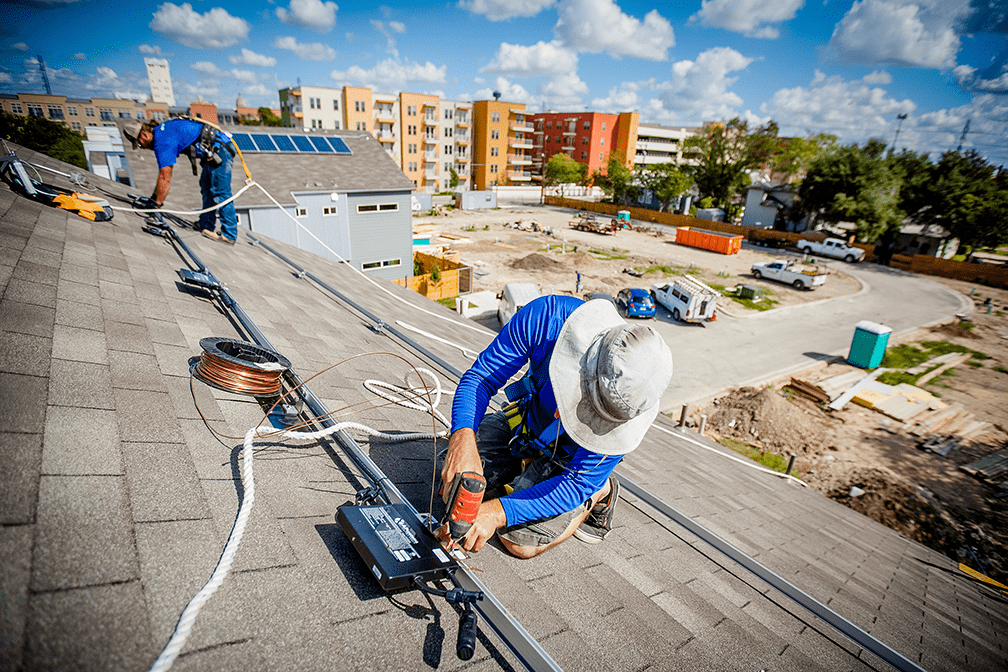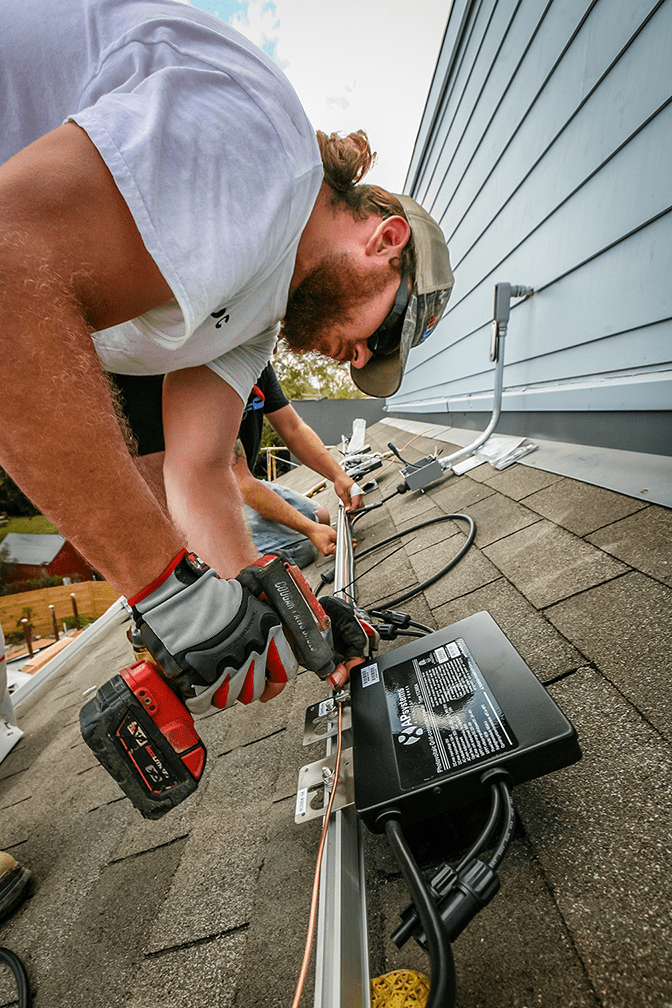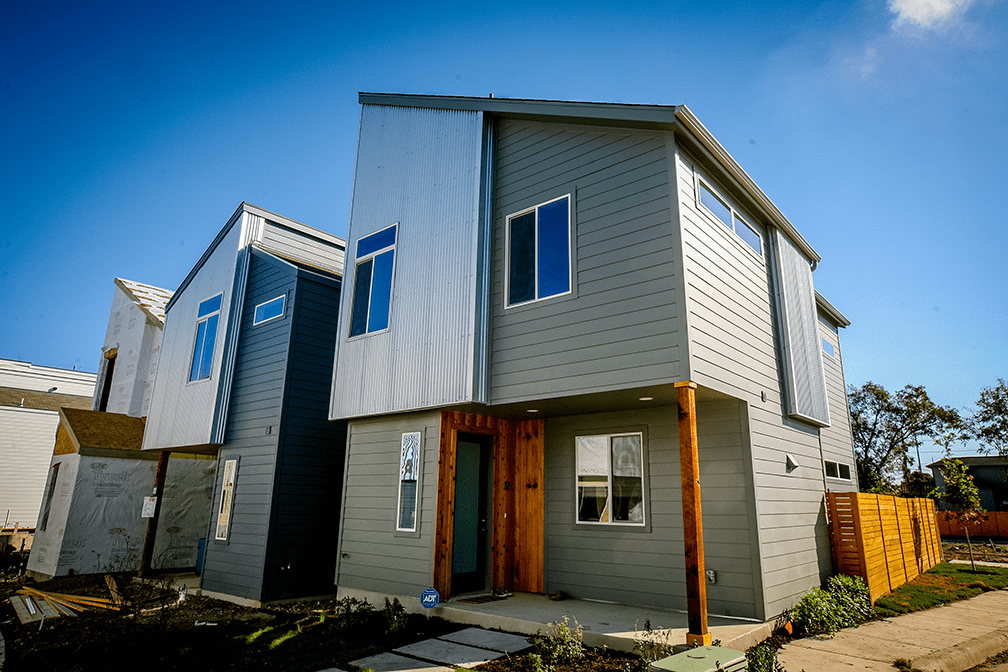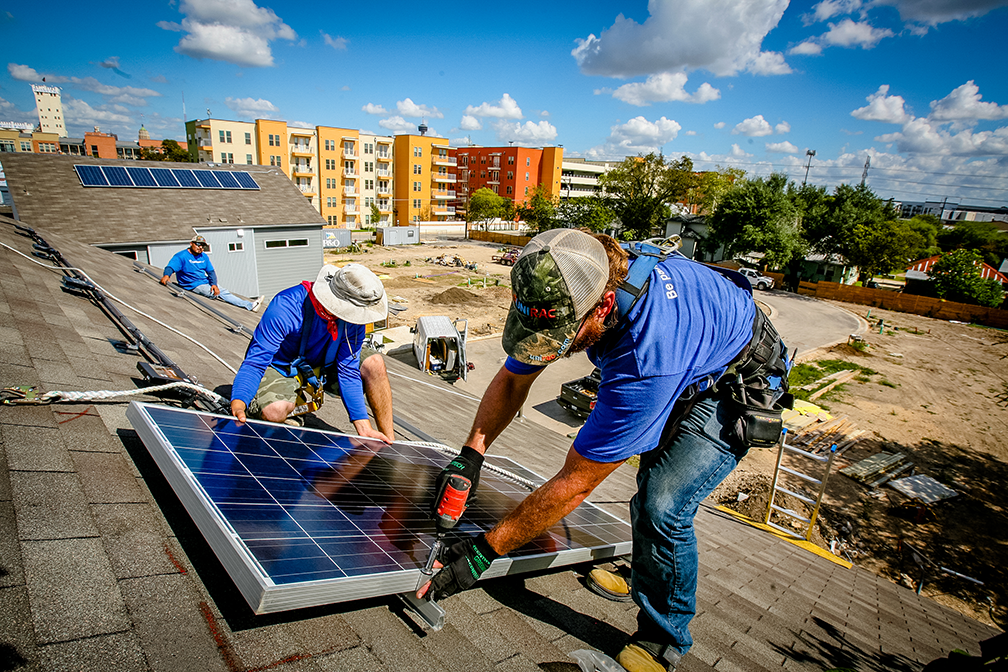When it comes to solar growth, it doesn’t get much hotter than San Antonio.
The market ranked no. 6 nationally for metropolitan growth in 2015, and no. 7 for the spread of solar, setting the pace for the Lone Star State.

Those trends converge at 330 Clay Street, a 32-home planned-solar neighborhood by PSW Real Estate now underway in the San Antonio’s arts and culture district, at the south edge of downtown.
Billed as “an oasis in the heart of the city,” the New Urbanism-inspired project features geometrically distinct homes clustered around a winding pedestrian path and drought-friendly, native vegetation. The modern designs are stylish, with acute angles, dramatic roof slopes, and accents of corrugated metal and cedar.
Efficiency features abound, from eco-friendly siding to high-performance windows, tankless water systems with “smart” fixtures, and the latest heat-pump systems for indoor climate control. Sustainable, low-impact materials are used throughout.
Topping it off is solar, with a compact array designed onto every single roof.
Austin-based installer Lighthouse Solar is pairing APsystems YC500 dual-module microinverters with Phono Sun 310W modules. Capacity across the whole neighborhood will be about 73kW from 234 modules at buildout.

Lighthouse chose APsystems equipment on the recommendation of regional distributor The Power Store, said Burke Ruder, procurement manager.
The Lighthouse installation team found the dual-module microinverters made for a quick install, and less time on the roof under the punishing Texas sun.
“Pretty easy wire management – just plug n’ play, man,” said Josh Bernard, one of the three-man crew at Clay Street.
Elijah Zane Echeveste, PSW Real Estate sales consultant for San Antonio, said PSW has been including a solar component on its homes for about three years.
Individual arrays at 330 Clay Street are modest – seven or eight modules per roof – putting solar onto every home while keeping price points attractive to a range of buyers. Home start at $295,000 for 1,250-sf, two-bedroom unit.
The energy package is paying off in early interest from buyers.

“Solar was important, and green-built was important,” said David McDonald, 330 Clay Street’s very first resident. On a recent afternoon, the expatriate Briton was taking delivery of appliances even as the half-finished neighborhood around him thrummed with the sounds of construction.
“We do a lot of green builds back in the Britain,” McDonald said, “and this might be one of the first ones in San Antonio with the option of solar and all of the sort of ‘green’ things around the house.”
Several other projects are also planned or underway in the corridor, including a sprawling former Lone Star brewery complex slated for mixed-use redevelopment on the banks of the San Antonio River.
The influx of stylish new residential and commercial development amplifies Southtown’s reputation as the city’s hot “bohemian” center for galleries, nightlife and culture.
“The area was important – we didn’t want to go outside of downtown,” McDonald said. “You can walk to all the restaurants and bars, even walk into downtown. We were the first to sign up, and it’ll be a good investment for us.”
The 330 Clay Street project reflects a fast-growing local solar market.
San Antonio is the top-ranked market in Texas, according to a recent report by Environment America. Solar capacity within the city limits jumped 23 percent year over year, from 88 megawatts to 108 megawatts – with significantly more capacity coming online in surrounding areas thanks to utility-scale solar farms.

About 207 megawatts were installed statewide in 2015, according to Environment Texas. Solar advocates credit a successful incentive program, which has fed consumer interest despite the state not having a net-metering law.
“Solar is an attractive feature for our buyers,” said Echeveste of PSW. “One of the largest reasons is that the solar panels reduce cost in energy bills and also increase the value of the homes. There is an environmental responsibility aspect with buyers wanting to be a part of this.”
 Vegas, Here We Come!July 22, 2025 - 11:40 pm
Vegas, Here We Come!July 22, 2025 - 11:40 pm Meet Solar PupAugust 7, 2025 - 5:57 am
Meet Solar PupAugust 7, 2025 - 5:57 am APsystems Featured in Solar Builder: Leading the Charge on AI in SolarAugust 7, 2025 - 6:21 am
APsystems Featured in Solar Builder: Leading the Charge on AI in SolarAugust 7, 2025 - 6:21 am TEDDY Talks Takes Scottsdale: Two New Episodes Live!August 7, 2025 - 5:53 am
TEDDY Talks Takes Scottsdale: Two New Episodes Live!August 7, 2025 - 5:53 am Review APsystems & Win a $50 Starbucks Card!August 4, 2025 - 2:35 am
Review APsystems & Win a $50 Starbucks Card!August 4, 2025 - 2:35 am



APsystems joins Sungage Financial approved vendor list
/in General News, Press Releases/by APsystems TeamFOR IMMEDIATE RELEASE
SEATTLE – APsystems microinverters have joined the popular Sungage solar financing approved vendor list.
The partnership brings the APsystems advanced microinverter line to a powerful residential solar lending platform, in response to requests from leading national solar installers.
Sungage Financial provides homeowners with easy, online access to low-cost financing for solar equipment. Headquartered in Boston, Mass., Sungage Financial partners with leading solar installers and institutional investors to help homeowners save money on energy. For more information, visit www.sungage.com.
The company was founded in 2011 by entrepreneur Sara Ross, who was looking for an easy way to finance a solar energy system for her home. Ross, now Sungage CEO, built a business bridging the gap between homeowners, installers and financial institutions.
Sungage has continued to grow, focusing exclusively on delivering consumer-friendly financing options that make it simple for homeowners to go solar and save more money. The company has been profiled in leading journals including GreenTech Media, Bloomberg and the Boston Globe.
APsystems was founded in Silicon Valley in 2009, and was first to market with innovative solar products including the groundbreaking YC500, the first dual-module microinverter, and the YC1000 true 3-phase, four-module unit.
APsystems is the second largest supplier of solar microinverters and the third-largest MLPE provider in the world. APsystems microinverters have about 30 percent fewer components than competing brands, leading to higher reliability and lower costs at every point in the production and distribution chain.
___________
About Sungage Financial:
Sungage Financial provides homeowners with easy, online access to low-cost financing for solar equipment. Headquartered in Boston, MA, Sungage partners with leading solar installers and institutional investors to help homeowners save money on energy. An innovator in solar finance, Sungage launched the nation’s first secured solar loan program in Connecticut in 2013. The company is committed to helping homeowners save more through ownership. For more information, please visit www.sungagefinancial.com.
APsystems YC1000-3 microinverter certified for Los Angeles market
/in General News, Press Coverage/by APsystems TeamThe APsystems YC1000-3 microinverter has been certified for use in commercial PV systems in the Los Angeles market.
General Approval certifies compliance with Section 93.0303 of the Los Angeles City Electrical Code, “New Methods and Materials of Construction.”
The YC1000-3 is the industry’s first true 3-phase, four-module microinverter, specially designed and built for commercial PV applications. It is available in both 208V and 277/480V configurations.
“The YC1000 created the market for microinverter technology in the commercial PV segment,” said Andrew Nichols, APsystems Senior Vice President of Sales. “These challenging environments demand a rugged unit, and certification under the high standards of Los Angeles and other local jurisdictions show that it’s built for both safety and reliability.”
The City of Los Angeles previously certified the APsystems YC500i microinverter, a powerful dual-module, single-phase unit designed for today’s high-output modules.
Both the YC1000 and the YC500i microinverter are available for order through APsystems U.S. distribution channels.
Best wishes for a joyous holiday season!
/in General News/by APsystems TeamBest wishes for a joyous holiday season and a very bright and happy New Year. – Your friends at APsystems
APsystems upgrades EMA monitoring website with more data and improved interface
/in General News, Press Releases/by APsystems TeamFOR IMMEDIATE RELEASE
SEATTLE, JIAXING, LYON– APsystems today announced the launch of a new, redesigned version of its Energy Monitoring & Analysis (EMA) website APsystemsEMA.com.
The web-based platform, available for free on any connected device, monitors and reports module-level energy production of solar arrays which utilize APsystems inverters and provides that information to homeowners and end users in a convenient and user-friendly format.
The new EMA website is active and available now, the result of a seamless transition from the previous site to the new interface. The added functionality addresses the high demand for detailed data and enhanced capability in a more user-friendly experience for the growing and competitive solar industry.
“We are excited to re-launch our very popular EMA website.” said Wesley Tong, APsystems chief marketing officer. “The site already hosts tens of thousands of homeowners and end users all over the world who view their APsystems solar array performance online and through the APsystems EMA App. These new design improvements now give them an even more in-depth view of their system energy production, improved reporting and additional historical data in a clean, comprehensive and dynamic user interface.”
Users can view their solar array performance using the same URL and log-in information as before at APsystemsEMA.com, through the APsystems EMA App or by visiting the APsystems website at APsystems.com and clicking “EMA Login” at the top right portion of the homepage.
2016 Project of the Year Competition – $1,000 Award
/in Contests, General News/by APsystems TeamDear APsystems installer,
It’s been another great year for APsystems and we have you, our solar partners, to thank for it. You’ve put our advanced microinverter technology to work for customers in markets across the country.
Now it’s time once again to look back on the great solar successes of the past year and share your very best stories with the industry and the world.
Tell us about your very best project – what set it apart in terms of scale, design, power output, challenging conditions, or your creative application of APsystems microinverter technology.
We’d like you to submit the project details here, including a brief write-up about your best installation, or more – enter all the projects you like. Remember to include some high-res photographs and any close-ups showing our microinverters in action. Your project can be completed or still in process. Entries will be judged by our APsystems team.
We’ll be honoring top projects in both Residential and Commercial categories.
And we’ll announce the APsystems Solar Project of the Year Award winners early in the new year through announcements and promotions that will highlight your project and your company. APsystems is committed to helping you grow your solar business even as we grow ours, so this is a cross-promotion opportunity you’ll definitely want to take advantage of.
The winner in each category will receive $1,000.
Our contest last year generated great interest from installers and brought out some fantastic projects; you can see the winners here.
Now we’re excited to present this competition, highlighting the very best APsystems microinverter installations of 2016.
Submit your project entries by January 6th 2017 using the form at right and high resolution photos sent via email to media@APsystems.com. Please read the terms and conditions below before entering.
If you have any questions, please contact our marketing coordinator.
New 32-home San Antonio project powered by APsystems micros
/in Article, Case Studies, General News/by APsystems TeamWhen it comes to solar growth, it doesn’t get much hotter than San Antonio.
The market ranked no. 6 nationally for metropolitan growth in 2015, and no. 7 for the spread of solar, setting the pace for the Lone Star State.
Those trends converge at 330 Clay Street, a 32-home planned-solar neighborhood by PSW Real Estate now underway in the San Antonio’s arts and culture district, at the south edge of downtown.
Billed as “an oasis in the heart of the city,” the New Urbanism-inspired project features geometrically distinct homes clustered around a winding pedestrian path and drought-friendly, native vegetation. The modern designs are stylish, with acute angles, dramatic roof slopes, and accents of corrugated metal and cedar.
Efficiency features abound, from eco-friendly siding to high-performance windows, tankless water systems with “smart” fixtures, and the latest heat-pump systems for indoor climate control. Sustainable, low-impact materials are used throughout.
Topping it off is solar, with a compact array designed onto every single roof.
Austin-based installer Lighthouse Solar is pairing APsystems YC500 dual-module microinverters with Phono Sun 310W modules. Capacity across the whole neighborhood will be about 73kW from 234 modules at buildout.
Lighthouse chose APsystems equipment on the recommendation of regional distributor The Power Store, said Burke Ruder, procurement manager.
The Lighthouse installation team found the dual-module microinverters made for a quick install, and less time on the roof under the punishing Texas sun.
“Pretty easy wire management – just plug n’ play, man,” said Josh Bernard, one of the three-man crew at Clay Street.
Elijah Zane Echeveste, PSW Real Estate sales consultant for San Antonio, said PSW has been including a solar component on its homes for about three years.
Individual arrays at 330 Clay Street are modest – seven or eight modules per roof – putting solar onto every home while keeping price points attractive to a range of buyers. Home start at $295,000 for 1,250-sf, two-bedroom unit.
The energy package is paying off in early interest from buyers.
“Solar was important, and green-built was important,” said David McDonald, 330 Clay Street’s very first resident. On a recent afternoon, the expatriate Briton was taking delivery of appliances even as the half-finished neighborhood around him thrummed with the sounds of construction.
“We do a lot of green builds back in the Britain,” McDonald said, “and this might be one of the first ones in San Antonio with the option of solar and all of the sort of ‘green’ things around the house.”
Several other projects are also planned or underway in the corridor, including a sprawling former Lone Star brewery complex slated for mixed-use redevelopment on the banks of the San Antonio River.
The influx of stylish new residential and commercial development amplifies Southtown’s reputation as the city’s hot “bohemian” center for galleries, nightlife and culture.
“The area was important – we didn’t want to go outside of downtown,” McDonald said. “You can walk to all the restaurants and bars, even walk into downtown. We were the first to sign up, and it’ll be a good investment for us.”
The 330 Clay Street project reflects a fast-growing local solar market.
San Antonio is the top-ranked market in Texas, according to a recent report by Environment America. Solar capacity within the city limits jumped 23 percent year over year, from 88 megawatts to 108 megawatts – with significantly more capacity coming online in surrounding areas thanks to utility-scale solar farms.
About 207 megawatts were installed statewide in 2015, according to Environment Texas. Solar advocates credit a successful incentive program, which has fed consumer interest despite the state not having a net-metering law.
“Solar is an attractive feature for our buyers,” said Echeveste of PSW. “One of the largest reasons is that the solar panels reduce cost in energy bills and also increase the value of the homes. There is an environmental responsibility aspect with buyers wanting to be a part of this.”
Multi-module micros touted in Solar Builder
/in General News, Press Coverage/by APsystems TeamA microinverter that handles more than one module is not just quicker for install – it’s an investment in long-term reliability. Fewer units per array mean fewer potential points of failure, notes Chris Barrett, director of engineering and technical services for APsystems.
All new YC500i microinverter certified for Los Angeles market
/in General News, Press Coverage/by APsystems TeamThe APsystems YC500i microinverter with EnergyMax™ has been certified for use in the Los Angeles market.
General Approval under the City of Los Angeles’ rigorous certification process was announced by the Department of Building and Safety, following testing by the Los Angeles City Electrical Testing Laboratory.
“The YC500i microinverter is built for safety and reliability, to meet the highest standards of local jurisdictions like the City of Los Angeles,” said Andrew Nichols, APsystems senior director of sales.
“We’re excited to earn certification and bring this powerful new unit to such a dynamic and fast-growing metropolitan market.”
EnergyMax™ technology allows the dual-module microinverter to produce 274 watts peak output per side (548W total), an almost 10 percent increase in peak power output over conventional microinverters to harvest the power of today’s high-output PV modules.
The YC500i builds on the same advanced platform as the popular YC500A flagship model. EnergyMax™ technology developed by APsystems maximizes the inverter’s output for higher energy harvest across the solar array.
The unit utilizes a trunk cable, offering installers an alternative to the daisy-chain design of APsystems YC500A microinverters. This provides a solution for installers who favor trunk cable architecture as well as markets where regulatory bodies prefer an integrated ground.
The YC500i microinverter is now available for order through APsystems U.S. distribution channels. Email sales@APsystems.com for ordering information.
Solar MLPE hacks for the installer edge
/in Article, General News/by APsystems TeamOne challenge in this effort to reduce labor costs, is the growth in utilization of module-level power electronics (MLPEs) such as microinverters and DC optimizers. Unlike string inverters which, for residential applications, typically mean a single string inverter is serving all the PV modules on the roof, each MLPE is typically serving a single module. Although an MLPE solar system is often more expensive in initial capital costs and more labor-intensive to install compared with string inverters, it also has a better levelized cost of energy (LCOE) over string inverters as MLPE systems produce more energy over the life of system. It makes sense, then, why MLPE systems comprised 62% of the U.S. residential solar market in 2015, according to GTM Research, and the market isn’t done there as MLPE is predicted to be the fastest-growing product segment over the next five years.
Installers are feeling the time crunch and the challenge today is even greater to take a high-demand yet labor-intensive product and still perform a profitable installation. Let’s take a look at a few ways to streamline the MLPE installation process with some serious solar hacks.
Microinverters which serve multiple modules exist today and with 2-to-1 and even 4-to-1 module to microinverter options available, homeowners can still get the benefits of an MLPE systems with independent MPPT per module, while installers cleverly reduce the amount of units they’re having to put on the roof by 50% to 75%.
MLPE ARCHITECTURE
Most MLPE systems utilize a trunk bus cable to which installers then attach every microinverter. Not only are trunk cables an expensive part of the system, but placing it on the roof and securing the cable to the racking takes time. Products, such as the APsystems YC500A, utilize a daisy-chain method of cabling and do away with the trunk cable. What’s more, the daisy chain is pre-integrated into the unit so it comes completely pre-cabled and ready to go.
Most solar equipment manufacturers offer free training webinars and videos on their products anymore so absolutely take advantage of this. Don’t miss out on the time (and money) saving tips you can pick up in a short training course or online video series.
GATEWAY SET-UP
The gateway communication unit for microinverter installations can be a breeze if installers follow a few simple tips for commissioning the system. Connect the gateway to the internet via a standard Ethernet cable so it can download the most current firmware before you begin to commission the system. Ideally, you’ll want to do this after the inverter installation but before module installation so the unit can update while your team puts panels on the roof so you don’t lose time. Be sure to connect cables in the right order as some gateways may take longer if power is applied before the network cable (unless the system will be connected via Wi-Fi). Obtaining the homeowner’s Wi-Fi network information and password before hitting the jobsite will also save you time in connecting the gateway.
TIME-SAVING APPS
There are some amazing apps out there for solar installers that can help installers streamline system setup. ArrayApp by APsystems, for example, allows installers to create the homeowner account for online monitoring, scan units directly without having to wait for up to 30 minutes for auto-detection of the inverters and create the array site map all from their mobile phone or tablet. Simply search for ArrayApp on your iPhone App Store or Google Play for Android devices.
Taking advantage of these time-saving measures can save an installer money but also help them get more installations completed in a single day. As the solar industry continues to lean heavily toward MLPE systems, finding ways to install faster and more effectively can mean the difference between a profitable operation and one that struggles to be competitive. Be sure to do your research, training, find out what other installers are doing and build your own list of valuable solar installation hacks.
APsystems reveals competitive edge on Solar Power World podcast
/in General News, Podcast/by APsystems TeamA smart microinverter takes a smart chip – and every APsystems unit has one inside.
The powerful FPGA chip that drives APsystems advanced microinverters is among the topics covered by Solar Power World editor Kathie Zipp and Jason Higginson, APsystems senior director of marketing, during a recent interview.
The pair sat down recently for an informative program on solar technology, the fast-growing Module Level Power Electronics segment and other topics.
Listen to the podcast here.